
Electronic english version since 2022 |
The newspaper was founded in November 1957
| |
|
Number 31 (4729) |
Conferences
Both theorists and experimentalists met at CMT-2024
On 15 - 29 July, the next International Conference "Modern Problems of Condensed Matter Theory" (CMT-2024) was successfully held at the Bogolyubov Laboratory of Theoretical Physics. The main organizer of the Conference was the Department of Condensed Matter Theory (DCMT) of the Bogolyubov Laboratory of Theoretical Physics, co-chairs were the Bogolyubov Laboratory employees Michal Hnatych and Vladimir Osipov. Chairman of the Programme Committee was Alexander Povolotsky.
This is the second conference in a series of theoretical conferences dedicated to condensed matter physics, organized by our department. The peculiarity of these conferences is the shift of the main programme emphasis to theoretical research. Nevertheless, as at the previous event, there were several reports dedicated to experimental issues. In order to "legitimize" the experimenters, the Organizing Committee prudently expanded the list of key topics:
- complex materials (high temperature superconductors, superconducting hybrid structures, fractal structures, functional materials),
- nanostructures and nanomaterials,
- prototypes of statistical physics of complex systems,
- techniques of quantum field theory in complex systems,
- modern experimental research.
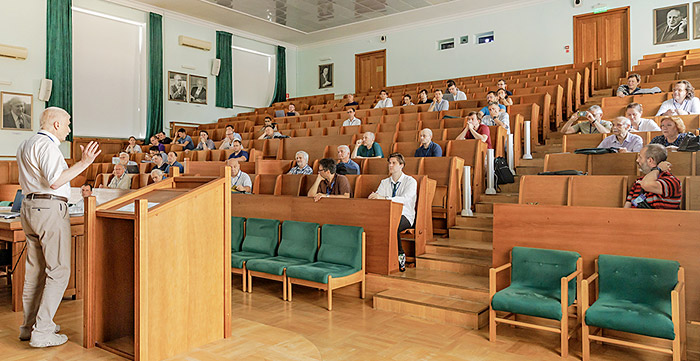
Despite the fact that the Conference of the CMT series has the ordinal number two, it does not mean that there is no rich history here. In fact, the latest conference is the result of the evolution of a large cycle of events organized by our department, the first of which was held in distant July 2008 and was called International Conference Dubna-Nano 2008. This circumstance has two important consequences. Firstly, we as organizers constantly studied the experience of previous events in order to find the most adequate and efficient way of holding.
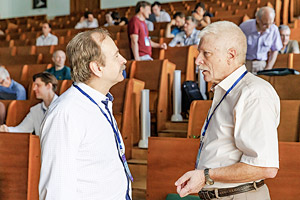 Secondly, our conferences have acquired a company of loyal friends that always come to Dubna with pleasure. These circumstances helped to hold CMT-2024 both at a high scientific and at a high organizational level.
Secondly, our conferences have acquired a company of loyal friends that always come to Dubna with pleasure. These circumstances helped to hold CMT-2024 both at a high scientific and at a high organizational level.
Another distinctive feature of the past conference was the experiment with the introduction of daily parallel sections in the second half of the day. It allowed to significantly increase the time of plenary and oral reports, thereby increasing the comfort of participation of both speakers and listeners. The duration of oral plenary and regular oral reports was 45 and 25 minutes, respectively.
A feature of solid-state science is that it is very much a derivative of current experimental research. And after listening to the reports of theorists, one can make a very clear conclusion about which topics are currently a trend among experimenters.
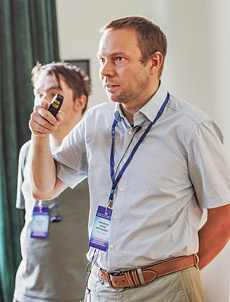 |
| Corresponding Member of the Russian Academy of Sciences Sergey Tarasenko (St. Petersburg) |
Another topical area related to the experiment is the description of the electrical response of a two-dimensional electron gas to structured radiation in the terahertz range. Structured radiation is vector optical beams composed of plane waves with different polarization, or twisted optical beams carrying orbital angular momentum. Corresponding Member of the Russian Academy of Sciences Sergey Tarasenko (St. Petersburg) gave a report on what local currents can be generated by such exotic beams and according to what physical mechanisms.
The investigation of two-dimensional materials is still a relevant area. Thus, at the Conference, a report was presented by Professor Leonid Chernozatonsky (Moscow), in which he demonstrated the fundamental possibility of new diamond-like nitride two-dimensional layered structures - nitridans. The latter, in addition to having an aesthetic moire structure, possess unique electronic and optical properties.
 |
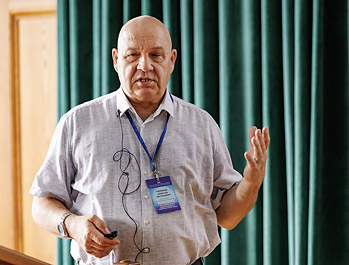 |
| Professor Leonid Chernozatonsky (Moscow) | Professor Alexey Romanov (St. Petersburg) |
A number of reports can be considered a brief and relatively popular introduction to the large original field of solid-state physics.
One of these reports was the speech of Professor Alexey Romanov (St. Petersburg), a recognized classic in this field that opened the Conference, on the nature, type and impact of rotational defects, disclinations on various properties of solids.
One of the most popular issues that theoreticians are currently interested in is "Josephsonics". Scientists extensively fantasize about what exotic design can be invented and implemented based on the Josephson effect. Reports from this area were presented in an impressive number. For example, Professor Yakov Fominov (Chernogolovka) spoke about the possibility of producing a diode based on a circuit of two asymmetric superconducting magnetometers (SQUIDs). Vitaly Bolginov (Chernogolovka) made a report on the experience of practical implementation of a sigmoid neuron based on a circuit with a Josephson junction and the issues that arise due to the impact of electromagnetic fields occurring in this device on the superconducting junction.


From a more general standpoint, the issues of describing the interaction of superconductors with electromagnetic radiation were discussed by Professor Alexander Melnikov (Dolgoprudny) in his report.
The purely "experimental" report by Professor Irina Antonova (Novosibirsk) evoked a lively response from the audience. She spoke about her research group's investigations of the broad possibilities of using ultra-thin composite layers of graphene as humidity sensors, non-invasive glucose sensors based on sweat analysis, breath and touch sensors, as well as sensors for analyzing chemical solutions.
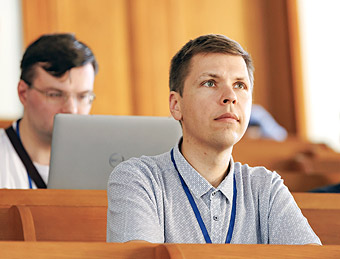
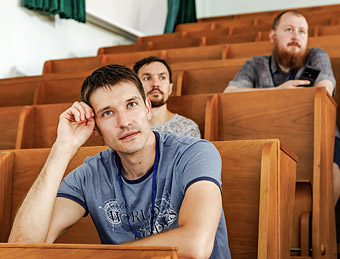
One of the most popular areas of modern materials science is the involvement of neural networks in research. Physicists try to "train" molecular dynamic potentials on large sets of small structures calculated with precise but slow techniques of quantum chemistry using artificial intelligence that in turn allow to stimulate quite macroscopic objects containing millions of atoms. A plenary report on this topic was presented at the Conference by Professor Nikolay Shchelkachev (Troitsk).
Of course, the reports mentioned here do not even come close to exhausting the set of the most interesting reports presented at the Conference. The author of the article rather tried to ensure that they reflect the degree of popularity of a particular scientific area for the current year 2024.
The Conference was attended by 94 scientists. The scientific programme included 68 oral and 14 poster reports. Along with JINR employees, there were representatives of all major Russian scientific centres: Moscow, St. Petersburg, Novosibirsk, Yekaterinburg, Kazan, Vladivostok and scientists from Slovakia, Serbia, India and Vietnam were present as well.

As many have noted, the Conference was held in a warm and friendly atmosphere, leaving a lot of pleasant memories. The main point of such conferences, apparently, is how many new, interesting and inspiring scientific ideas each participant has taken away. Judging by numerous reviews, CMT-2024 was also fine with this.
In conclusion, I would like to thank Directorate of the Laboratory of Theoretical Physics and all the staff of the Laboratory and the Joint Institute that helped to organize the event. The Programme Committee deserves special thanks. Of course, it is necessary to emphasize the contribution of the CMT-2024 Organizing Committee: Nikita Lebedev, Georgy Kalagov, Yury Molotkov, Lukasz Mizhishin, Kirill Kulikov and Olga Korotchik.
Vsevolod KATKOV,
Scientific Secretary of the Conference,
photo by Elena PUZYNINA